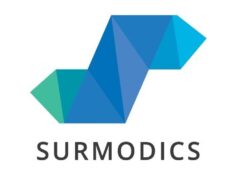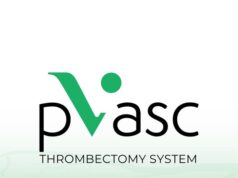
During the CX Peripheral and Aortic Workshops at the 2019 Charing Cross Symposium (London, UK), experts demonstrated a wide range of peripheral and aortic technologies and techniques. Throughout break times, supervised learning has been carried out at hands-on stations, enabling delegates to test and improve their practical skills. “It is all down to ease and ergonomics,” said an industry representative. “People are hands-on; surgeons are hands-on,” they added, highlighting the demand for such workshops in the field of vascular surgery.
In the Peripheral Workshop, Georg Bach (Bulach, Switzerland) introduced the Pulsar-18 T3 (Biotronik), a stent system indicated for use in patients with atherosclerotic disease, as well as for the treatment of insufficient results after percutaneous transluminal angioplasty. Speaking to Vascular News, he emphasised the importance of tactile user experience: “We have samples here and we let [the delegates] deploy the stent themselves, to show them how accurate it is.” He added: “It is easier to connect with people… giving them something that they can physically hold.”
A recent addition to the UK market is Dabra (Destruction of arteriosclerotic blockages by laser radiation ablation; Ra Medical Systems), a minimally invasive excimer laser atherectomy system that nonthermally, photochemically ablates channels in vascular blockages. The technology was demonstrated for the first time at Charing Cross (CX Symposium), with the Peripheral Workshop helping to educate and inform delegates, as they were able to learn in a hands-on manner about this novel means of atherectomy.
In addition to the promotion of products, these workshops assist in raising awareness of important initiatives. Also residing in the Peripheral Workshop is Medi’s campaign, a company aimed at further educating CX delegates on peripheral arterial disease and its consequences, the most serious being amputation. “We are trying to encourage vascular surgeons to endorse the campaign, in order to make it stronger, as well as to encourage the screening of ankle-brachial pressure index to primary care. Everyone in the high-risk group should get screened for ankle brachial index, to check the state of their arteries. If this can be implemented, we would avoid the massive number of amputations.” To target delegates that are less informed about peripheral arterial disease, Medi has been handing out small red hourglasses, enabling the visualisation of how blood flow can be restricted in arteries.
At the Aortic Workshop, the PIUR tomographic ultrasound imaging system was demonstrated by Vikki Galgerud (Vienna, Austria), who told Vascular News that having this technology available “in the flesh” only helps facilitate discussion surrounding the important challenges presented this year at CX. With one study so far indicating that PIUR tomographic ultrasound has outperformed CT angiograms at detecting endoleaks, Galgerud alluded to the fact that further research is underway to extend the evidence-base for PIUR and its role in the post-surveillance of endovascular aneurysm repairs and endoleaks. A further highlight of the Aortic Workshop consisted of Gustavo Oderich (Rochester, USA) sharing his experience with the fusion imaging system, as he discussed how to simplify fenestrated endovascular aneurysm repair procedures using EVAR ASSIST 2.
So far, both the CX Peripheral and Aortic Worshops have facilitated peer-to-peer interactions between a world-class faculty and delegates from all over the world. From peripheral guidewires and novel atherectomy systems to innovative fenestrated endovascular aortic repair solutions, many have benefited in terms of hands-on practical experiences, supervised learning, and expert discussion.













